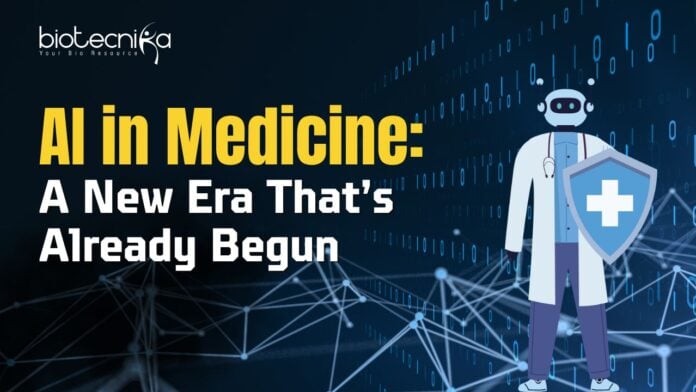AI in Medicine: A New Era That’s Already Begun
With the advent of technology, Artificial Intelligence (AI) is rapidly transforming the healthcare industry. AI is not only helping to predict certain conditions earlier, but also changing the way we treat and manage diseases.
The US Food and Drug Administration (FDA) has successfully curated a valuable resource. This resource contains all the data regarding the AI-Enabled Medical Devices. It is easily accessible to the general public, offering insights into AI-powered devices that the FDA has authorized. This acts as a guide to help healthcare professionals and patients understand how AI is reshaping the industry.
The importance of the list:
The patient using a wearable monitor can now gain a better understanding of the device by referring to this list. It would be beneficial for patients to know if the devices they use have AI tools to monitor their health data. With the help of this list, the devices that use AI in Medicine are becoming clearer and transparent.
It also demonstrates that each device has undergone a thorough evaluation, not only for its functionality, but also for its safety and effectiveness. The FDA doesn’t just examine whether AI is present; they also assess how it functions, whether it’s suitable for the device’s intended purpose, and whether it’s being used responsibly.
For patients, that means peace of mind. For healthcare professionals, it’s an opportunity to gain a deeper understanding of the tools they’re using. For innovators, it serves as a guide on how to develop the next generation of trusted medical devices.
This is not just a static list; the ranking evolves with the technology. Today, there are many simple AI devices, but techniques representing more advanced systems will be created very soon. Consider a large language model, such as ChatGPT or tools that can analyze an image together with some text and voices of the world, which scientists call multimodal AI.
In preparation for that future, the FDA is already on its way. They are working out some tagging methodologies with highlights for devices operating off these hyper-powerful AI systems. As a result, everyone —be it doctors, patients, or developers—knows exactly what kind of technology is behind the device.
And so they ask developers to be upfront about it. The better companies disclose to the FDA what AI is behind their products, the better it will guide and monitor this burgeoning industry.
Innovation with Responsibility
What makes this initiative exciting isn’t just the technology; it is the responsible approach behind it. The FDA isn’t just saying “yes” to AI in Medicine; they’re saying, “Let’s do this carefully, together.” They’re encouraging innovation while prioritizing patient safety, ensuring that as devices become smarter, they also remain trustworthy.
AI in healthcare is no longer just a trend; it is becoming a lifesaving companion. With the FDA’s support, the journey toward smarter, safer care is becoming more transparent, inclusive, and empowering for everyone involved.
So the next time you’re handed a medical device—whether it’s in a hospital or your own home—it might just have a little artificial intelligence inside. And now, thanks to the FDA’s efforts, you’ll know it’s there, and that it’s been put through a process designed to protect you. AI in Medicine paves a new frontier, and when it comes to our health, innovation should always come with a sense of peace of mind.
Here is the list of a few AI-Enabled Medical Devices
| Date | Sub. No. | Device (Short Name) | Company | Panel | Code |
|---|---|---|---|---|---|
| 05/30/25 | K251406 | BriefCase-Triage | Aidoc Medical | Radiology | QAS |
| 05/30/25 | K250236 | Swoop MR Imaging (V2) | Hyperfine | Radiology | LNH |
| 05/30/25 | K243863 | Opulus Lymphoma Precision | Roche Molecular | Radiology | QIH |
| 05/30/25 | K243005 | AudaxCeph Software | Audax d.o.o. | Radiology | QIH |
| 05/30/25 | K242830 | LensHooke X3 PRO Analyzer | Bonraybio | Hematology | POV |
| 05/30/25 | DEN240047 | Allix5 | Clairity | Radiology | SEZ |
| 05/29/25 | K250543 | Voluson Performance 16/18 | GE Medical | Radiology | IYN |
| 05/28/25 | K243378 | Rapid MLS | iSchemaview | Radiology | QIH |
| 05/28/25 | K250427 | DeepMets | Taiwan Medical Imaging | Radiology | QKB |
| 05/28/25 | K250367 | CoLumboX | Smart Soft Healthcare | Radiology | QIH |
| 05/27/25 | K250932 | DeepRhythmAI | Medicalgorithmics | Cardiology | DQK |
| 05/23/25 | K250005 | Clever One | Ewoosoft | Radiology | QIH |
| 05/23/25 | K243989 | Second Opinion 3D | Pearl | Radiology | QIH |
| 05/23/25 | K243937 | Accuro 3S | Rivanna Medical | Radiology | IYO |
| 05/23/25 | K242594 | DEEPECHO | DeepEcho | Radiology | IYN |
| 05/21/25 | K251276 | Swoop MR Imaging | Hyperfine | Radiology | LNH |
| 05/21/25 | K243866 | InVision Cardiac Amyloid | InVision Medical | Cardiology | SDJ |
| 05/21/25 | K243793 | EPIQ / Affiniti US Systems | Philips | Radiology | IYN |
| 05/21/25 | K243762 | Synapse 3D Tools (V7.0) | FUJIFILM | Radiology | QIH |
| 05/21/25 | K243122 | uMR Omega | Shanghai United Imaging | Radiology | LNH |
| 05/20/25 | K250370 | SCENARIA View P5.0 | FUJIFILM | Radiology | JAK |
| 05/16/25 | K243617 | uCT ATLAS + Dual Energy | Shanghai United Imaging | Radiology | JAK |
| 05/16/25 | K241671 | 6450 Ultrasound System (E80/E85) | Esaote | Radiology | IYN |
| 05/16/25 | K240554 | InferRead Lung CT.AI | Infervision | Radiology | OEB |
| 05/16/25 | K250086 | OTS Hip | Ortoma | Neurology | OLO |
| 05/14/25 | K242624 | uOmnispace.CT Software | Shanghai United Imaging | Radiology | QIH |
| 05/14/25 | K242437 | Smile Dx | Cube Click | Radiology | MYN |
| 05/09/25 | K251126 | SKOUT System | Iterative Health | GI/Urology | QNP |
| 05/09/25 | K251110 | EPIQ / Affiniti US Systems | Philips | Radiology | IYN |
| 05/09/25 | K243812 | Volta AF-Xplorer | Volta Medical | Cardiology | DQK |























